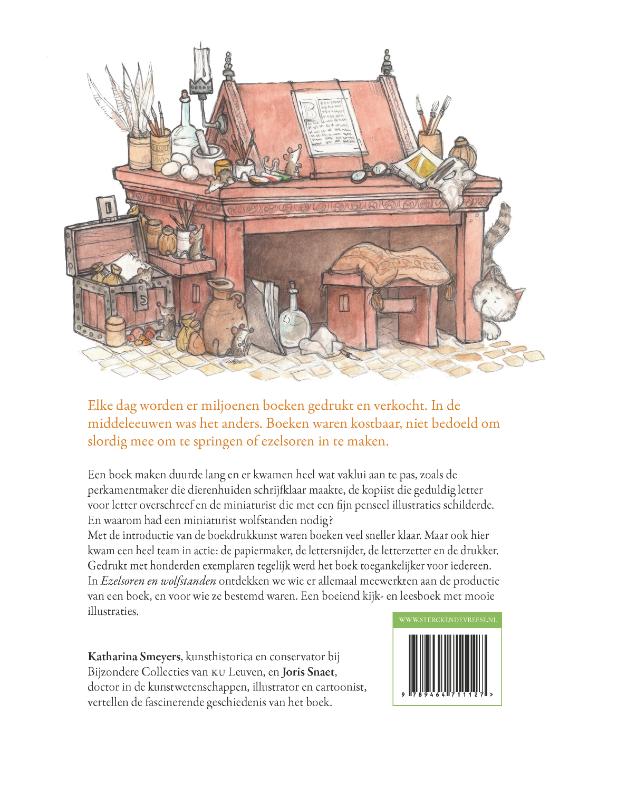Ezelsoren en wolfstanden
€ 24,90
Elke dag worden er miljoenen boeken gedrukt en verkocht. In de middeleeuwen was het anders. Boeken waren kostbaar, niet bedoeld om slordig mee om te springen of ezelsoren in te maken.
Een boek maken duurde lang en er kwamen heel wat vaklui aan te pas, zoals de perkamentmaker die dierenhuiden schrijfklaar maakte, de kopiist die geduldig letter voor letter overschreef en de miniaturist die met een fijn penseel illustraties schilderde. En waarom had een miniaturist wolfstanden nodig?
Met de introductie van de boekdrukkunst waren boeken veel sneller klaar. Maar ook hier kwam een heel team in actie: de papiermaker, de lettersnijder, de letterzetter en de drukker. Gedrukt met honderden exemplaren tegelijk werd het boek toegankelijker voor iedereen. In Ezelsoren en wolfstanden ontdekken we wie er allemaal meewerkten aan de productie van een boek, en voor wie ze bestemd waren. Een boeiend kijk- en leesboek met mooie illustraties.
Katharina Smeyers, kunsthistorica en conservator bij Bijzondere Collecties van KU Leuven, en Joris Snaet, doctor in de kunstwetenschappen, illustrator en cartoonist, vertellen de fascinerende geschiedenis van het boek.
Gerelateerde boeken
-
Ferdban
€ 49,90De Oudfriese oorkonden in Ferdban weerspiegelen het dagelijkse leven van gewone mensen en van de allerrijksten en allermachtigsten in Friesland. Ze gaan ook over zaken als vete en vrijheidsstrijd, de veelzijdige activiteiten van kloosters, de groeiende invloed van steden en de bijzondere positie van Ameland. Ze laten bovendien de transformatie van Friesland zien in de jaren kort na 1500, toen de roemruchte, maar in crisis verkerende Friese vrijheid werd afgelost door een strakke, maar tegelijk vernieuwende vorstenheerschappij. Een veelzijdiger inkijk in de Friese maatschappij in het herfsttij van de middeleeuwen en het prille begin van de nieuwe tijd is nauwelijks voorstelbaar.
Oebele Vries is historicus en gezaghebbend kenner van het Oudfries. Hij was universitair docent aan de Rijksuniversiteit Groningen en is nu gastonderzoeker bij de Fryske Akademy. Van zijn hand verscheen eerder Asega, is het dingtijd?, waarin hoogtepunten uit de Oudfriese wetsteksten centraal staan.
-
Op reis met de NTM
€ 17,50In 1880 werd de Nederlandsche Tramweg Maatschappij (NTM) opgericht. Doel van het bedrijf was in Nederland trambanen aan te leggen en te exploiteren, te beginnen met paardentrams, al snel gevolgd door de stoomtram.
Busliefhebber Melle van der Goot schetst in dit boek de geschiedenis van de NTM; de uitbreiding van het bedrijf in Noord-Nederland tot 1920 en de concurrentie van en overstap naar autobussen in de jaren dertig. Vervolgens beschrijft de auteur de woelige oorlogsjaren en de bloei van het bedrijf in het eerste decennium na de bevrijding, totdat de NTM in 1971 opging in de FRAM. Op reis met de NTM is rijk geïllustreerd met uniek beeldmateriaal uit privéverzamelingen en bedrijfsarchieven. -
Van Generatie op Generatie
€ 25,00De Joodse Gretha Zak (Margaretha) is nog maar net verlaten door haar echtgenoot Jozef de Hond als de
Duitsers in mei 1940 Nederland binnenvallen. De mogelijkheid om met haar oudste broer en dochter Liesje
naar Engeland te vluchten, lijkt een uitweg te bieden van het naderende onheil. De band met haar ouders
in Amsterdam trekt haar echter terug naar Amsterdam, waar ze als alleenstaande Joodse moeder haar
weg moet vinden te midden van anti-Joodse maatregelen die in rap tempo worden afgekondigd. Familie en
vrienden worden opgepakt en uiteindelijk worden ook Gretha en Liesje gearresteerd. Via de kampen Vught
en Westerbork wordt Gretha met het zogeheten Philips-transport gedeporteerd naar Auschwitz. Gretha
overleeft zelfs de beruchte dodenmarsen tegen het einde van de oorlog.In ‘Van Generatie op Generatie’ vertellen vier generaties over hun eigen ervaringen uit de Shoah, de
holocaust, of de impact ervan op hun leven. Het onthult niet alleen het aangrijpende verhaal van Gretha,
in 1991 verteld aan haar kleinzoon Marcel, maar ook het indrukwekkende relaas van haar dochter Liesje, de
moeder van Marcel, die wordt gered uit de Hollandsche Schouwburg en kon onderduiken bij een niet-Joodse
vriendin. Het volgt daarnaast de lotgevallen van Gretha oudste broer Meijer, een arts die zich aansloot bij de
Prinses Irene Brigade in Engeland en vocht tijdens D-Day. Tot slot lezen we over Deddie, het geliefde neefje,
dat in Sobibor werd vermoord. Diens naamplaatje, enkele jaren terug in het voormalige kamp opgegraven,
weigert Polen tot op heden aan de familie terug te geven.‘Van Generatie op Generatie’ is een boek over de impact van de Shoah op een Joodse familie, maar nog
meer over de opdracht om het verhaal door te vertellen aan hen die nu leven. De geschiedenis doorvertellen
ligt aan de basis van het Jodendom en is ook het motto van deze familie. Het boek kwam tot stand
nadat kleinzoon Marcel Koekoek samen met zijn moeder en zoon had meegewerkt aan de 4 mei (Covid)
herdenkings-podcast, en vervolgens contact zocht met journalist Rachel Levy. Het is een aangrijpend en
indrukwekkend eerbetoon aan de veerkracht van de menselijke geest te midden van een van de donkerste
perioden in de geschiedenis.Lees en vertel het door, L’dor Va-dor, van generatie op generatie, opdat dit nooit meer zal gebeuren.
-
Een Schricklijck Jaer
€ 25,00April 1672: koning Lodewijk XIV van Frankrijk verklaart de oorlog aan de Republiek der Zeven Verenigde Nederlanden. Een dag later volgt zijn bondgenoot koning Karel II van Engeland. De bisschoppen van Keulen en Münster gaan een maand later mee in het bondgenootschap en vallen begin juni de Republiek binnen. Een Schricklijck Jaer gaat over deze oorlog, de oorlog van 1672 in het noordoostelijk deel van de Republiek.
Na de bisschoppelijke triomftocht langs de Overijsselse vestingsteden – die als rijpe appels in handen van de bisschoppen vallen – volgt de aanval op Coevorden. Ook die ‘onneembare’ vesting in het noorden valt binnen tien dagen. Maar daarna keert het tij voor de bisschoppen. De stad Groningen houdt stand, ondanks de enorme bommenregen van de bisschop van Münster, die bij dat beleg zijn bijnaam ‘Bombenberend’ verdient. Aan het einde van het jaar 1672 volgt de herovering van Coevorden, een spannend verhaal dat de geschiedenis ingaat als ‘De verrassing van Coevorden’.
Maar daarmee is de oorlog in de noordelijke gebieden nog lang niet ten einde. De bisschop van Münster heeft meer pijlen op zijn boog, waardoor Coevorden in een bizarre situatie terechtkomt.
Als dan eindelijk alle vijandelijke legers zijn vertrokken, moet het land weer opgebouwd worden. Dan komen, als vanzelf, alle eerdere politieke tegenstellingen weer opzetten die een snelle en effi ciënte wederopbouw tegenhouden. Bovendien gaat de oorlog nog steeds door, in het buitenland weliswaar, maar de kosten worden verhaald op de inwoners van de Republiek, ook op de tot op het bot verarmde bevolking van de provincies Stad en Lande (nu provincie Groningen), de Landschap Drenthe en Overijssel. De gevolgen van de oorlog, vooral voor het dagelijks leven van de gewone inwoners in die provincies, vormen de afsluiting van het boek.





